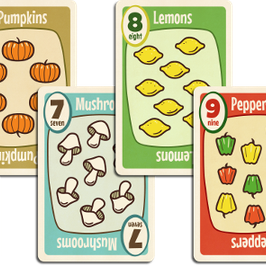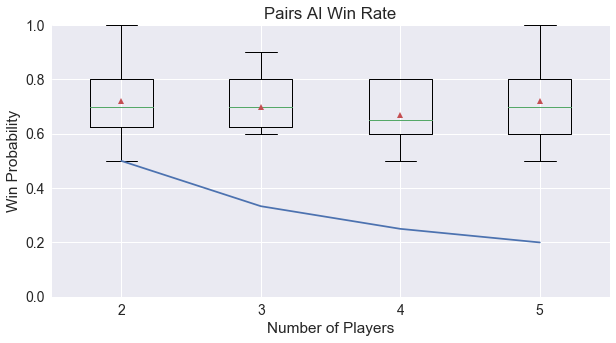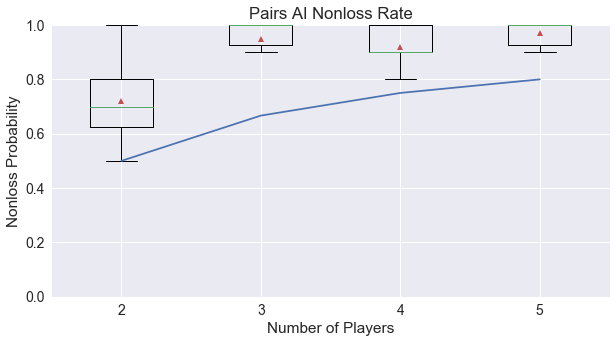
Now that Pairs is coded in RECYCLE, we can run many simulations in CardStock with both random and AI players. To gather statistics for this and the next post on heuristics, we ran 100 games with all random players, 100 games with one AI and the rest random players, and 100 games with all AI players. We did these simulations for 2, 3, 4, and 5 players. Let’s see if we can answer some basic questions about the game.
Are there sufficient choices for players?
Unlike Agram, Pairs is very consistent in the number of choices a player has on their turn: always 2.
A player can either end their turn, or flip up a new card from the STOCK location.
How does game length vary with the number of players?
Even though the choices are limited on each turn for a player, the length of the game is undetermined. This is the nature of many press-your-luck games; you never really know if you’ve gone too far unless you try.
So, how long is an average game of Pairs? Sometimes you will find a game published with a range of times
for game length (30-60 minutes), or that each player additional player adds a certain amount of time, say 10 minutes.
But the advertised game length for Pairs
is a definitive 15 minutes. Since we are working with simulated games, we won’t try to estimate the actual clock
time, and instead look at the average
number of calls to a choice block for a player decision, since these should be well-correlated.
In the rules, the number of points necessary to lose a game of Pairs is scaled to the number of players, according to the formula “Take 60, divide by the number of players, then add 1.” Hopefully, there is also a correlation between these ending points and the length of the game. If done well, we should see that the number of choices, thus the length of the game, is consistent for any number of players.

We can see in the graph above that there is good correspondence between the number of players and the length of the game, demonstrating that the scaling is having the desired effect. Maybe a different rule could be implemented to provide perfect consistency, however the loss of simplicity would not be worth the complication.
Interestingly, we also see that intelligent play make the game longer! In fact, the games with all AI players, have nearly twice as many decisions as those with all random players!
What could be causing this? For a random player, each choice, they are essentially flipping a coin, which means they will be more and more likely to have ended their turn as a round progresses. However, the AI players are much more likely to push their luck and keep drawing another card into their hand. With their Monte Carlo simulations, the AI players are actually playing the odds and betting many times that they will not get a pair if they keep drawing.
Can players be strategic in Pairs?
We see that AI players change the game length above, but does this correspond to improved performance? By looking at the results below, based on simulations with one AI player versus all other random players, we see the AI performed much better than expected! The AI is the lowest-scoring player in a majority of the games no matter how many players were playing.

And, this appears to be better than the AI performance in Agram! This could mean one of two things: either Pairs is an easier game for an AI to play than Agram, or there is more control over the luck and less chaos in Pairs than in Agram. See this great early article, Chaos Reigns by Larry Levy for more on control, chaos, and luck. I think this idea of chaos and luck could be formulated into another heuristic; I should have a better handle on how after examining a few more games.
Actually, since the goal in Pairs is to not lose as opposed to win outright with the lowest score, our next graph shows the “non-loss percentage” for the AI player in comparison to the expected probability of not losing for a random player. We can see the AI is drastically better than the random players, quickly approaching a non-loss probability of 1.

Up Next
Next post, we’ll see how Pairs measures up with our heuristics and look at the overall gameplay experience with all AI players. I’m pretty excited about what we will find.
Are there other questions or statistics you want to see about Pairs? Let me know in the comments below, and I’ll see if I can incorporate them in future posts. Thanks for reading!
(Image courtesy of BoardGameGeek)
comments powered by Disqus

